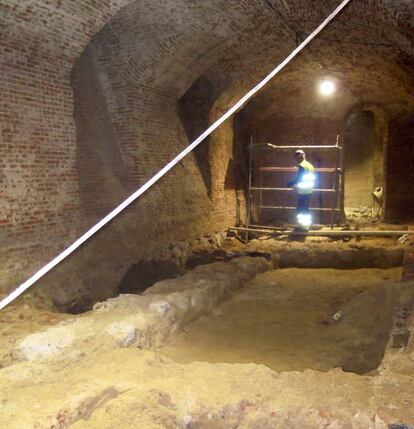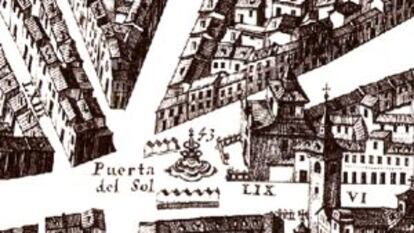From plague hospital to Apple store
After new find, archeologists will go on working to learn more about history of Madrid's Puerta del Sol

Archeologists excavating the cellars of what will be Apple's new flagship store in a 19th-century former hotel in Madrid's central Puerta del Sol square say they still have several weeks' work ahead of them.
Work was due to be finished in time for the store's opening this summer, an event that has now been delayed until Christmas.
The remains of what was once a church were discovered nearby during construction work on a new underground train line in June 2009, halting the project for 10 months. The ruins can now be seen in the entrance to Sol metro station.
Earthquakes, fires and French invasion

The Real de Corte hospital was built on the site of the San Andrés hermitage around 1529 on the orders of King Charles I, and authorized by a papal bull issued by Clement VII. Its 33 beds were initially for the use of plague victims, soldiers and officials of a court, which although itinerant, was increasingly focused on Madrid. In 1606, a small image of the Virgin Mary that had been found in Catalonia by two monks whose order ran the hospital was blessed by Pope Paul V, who named it the Buen Suceso (Good Fortune), and the name was subsequently used for both the church and the hospital.
The church tower burned down in 1620; a year later, Pope Gregory XV issued orders for the the hospital to be rebuilt. The church and the hospital survived the development of the Puerta del Sol city entrance, which finally disappeared in 1536, although the area retained the name. Bullfights and royal events were held close by, and the church was again damaged by fire in 1701. In 1755, tremors from the earthquake that destroyed much of Lisbon brought down the cross atop the Buen Suceso's tower, killing two young men below.
In 1808, the church was used as a refuge by local people fighting the French occupation forces, and many were killed there by Napoleon's troops. In 1854, the church was finally demolished. Today, the site sits above a new metro line. When the Apple store opens, information panels will offer an explanation of the history of the area and the buildings that have occupied the site for the last half millennium.
But the walls of an adjacent 15th-century hospital uncovered during the latest building work will not be maintained: Apple is to change the flooring of the basement so as to "symbolically" trace the outline of these newly discovered walls. The walls themselves will then be covered up again so the floor of the new store can be placed on top.
The technology giant's renovation of the former Paris Hotel, for decades topped by its landmark neon Tio Pepe sherry advertisement, led to the discovery in June of the outer walls of the Buen Suceso hospital, next to the church of the same name. Both buildings were demolished in 1854 to make room for the Puerta del Sol.
The Hotel Paris opened in 1863 and was the most luxurious place to stay in the city until the Ritz and the Palace opened in 1910 and 1912, respectively. It suffered a slow, but terminal decline until its closure in 2006, when the owners sold it for 80 million euros. The plan to reform the six-story, 6,000-square-meter building was approved by the regional government of Madrid in 2012 under the proviso that an archeological survey be carried out. After the discovery of the Buen Suceso church during the redevelopment of Sol station, the regional heritage organization said Apple's renovation would likely yield new finds.
No human remains were found during the excavation of the hospital. In contrast, when the church was excavated, diggers discovered remains from burials from the Peninsular War and the executions that followed the May 2, 1808 uprising against Napoleon's troops in the capital.
Nicolas Benet, the archeologist supervising the work, says stone walls from a prior construction have been discovered, but following the outline of the current building, which sits at the corner of Alcalá and the Carrera de San Jerónimo streets, and a wall that presumably belonged to the church, now covered by the Puerta del Sol. These are part of the interior walls of the hospital, and may provide a clue to the building's outline.
"There is very little information about the hospital, aside from a description of the wards, despite it having been a high-level hospital, for its day," says Benet.
After the work is completed by the end of the summer, it will be included with other excavation surveys that will add to the existing body of work on the history of the center of Madrid.
Tu suscripción se está usando en otro dispositivo
¿Quieres añadir otro usuario a tu suscripción?
Si continúas leyendo en este dispositivo, no se podrá leer en el otro.
FlechaTu suscripción se está usando en otro dispositivo y solo puedes acceder a EL PAÍS desde un dispositivo a la vez.
Si quieres compartir tu cuenta, cambia tu suscripción a la modalidad Premium, así podrás añadir otro usuario. Cada uno accederá con su propia cuenta de email, lo que os permitirá personalizar vuestra experiencia en EL PAÍS.
¿Tienes una suscripción de empresa? Accede aquí para contratar más cuentas.
En el caso de no saber quién está usando tu cuenta, te recomendamos cambiar tu contraseña aquí.
Si decides continuar compartiendo tu cuenta, este mensaje se mostrará en tu dispositivo y en el de la otra persona que está usando tu cuenta de forma indefinida, afectando a tu experiencia de lectura. Puedes consultar aquí los términos y condiciones de la suscripción digital.
More information
Últimas noticias
The complicated life of Francesca Albanese: A rising figure in Italy but barred from every bank by Trump’s sanctions
Half of Scotland is in the hands of 420 property owners
Pinochet’s victims grapple with José Antonio Kast’s rise in Chile
Reinhard Genzel, Nobel laureate in physics: ‘One-minute videos will never give you the truth’
Most viewed
- Pablo Escobar’s hippos: A serious environmental problem, 40 years on
- Why we lost the habit of sleeping in two segments and how that changed our sense of time
- Charles Dubouloz, mountaineering star, retires at 36 with a farewell tour inspired by Walter Bonatti
- Reinhard Genzel, Nobel laureate in physics: ‘One-minute videos will never give you the truth’
- The Florida Keys tourist paradise is besieged by immigration agents: ‘We’ve never seen anything like this’









































